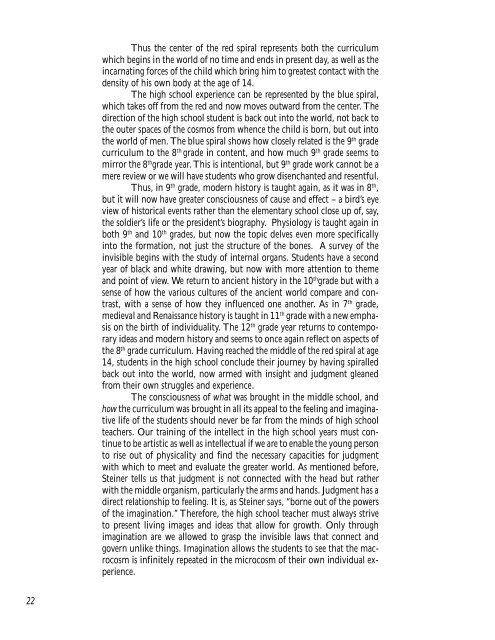Colloquium on English - Research Institute for Waldorf Education
Colloquium on English - Research Institute for Waldorf Education
Colloquium on English - Research Institute for Waldorf Education
Create successful ePaper yourself
Turn your PDF publications into a flip-book with our unique Google optimized e-Paper software.
22<br />
Thus the center of the red spiral represents both the curriculum<br />
which begins in the world of no time and ends in present day, as well as the<br />
incarnating <strong>for</strong>ces of the child which bring him to greatest c<strong>on</strong>tact with the<br />
density of his own body at the age of 14.<br />
The high school experience can be represented by the blue spiral,<br />
which takes off from the red and now moves outward from the center. The<br />
directi<strong>on</strong> of the high school student is back out into the world, not back to<br />
the outer spaces of the cosmos from whence the child is born, but out into<br />
the world of men. The blue spiral shows how closely related is the 9 th grade<br />
curriculum to the 8 th grade in c<strong>on</strong>tent, and how much 9 th grade seems to<br />
mirror the 8 th grade year. This is intenti<strong>on</strong>al, but 9 th grade work cannot be a<br />
mere review or we will have students who grow disenchanted and resentful.<br />
Thus, in 9 th grade, modern history is taught again, as it was in 8 th ,<br />
but it will now have greater c<strong>on</strong>sciousness of cause and effect – a bird’s eye<br />
view of historical events rather than the elementary school close up of, say,<br />
the soldier’s life or the president’s biography. Physiology is taught again in<br />
both 9 th and 10 th grades, but now the topic delves even more specifically<br />
into the <strong>for</strong>mati<strong>on</strong>, not just the structure of the b<strong>on</strong>es. A survey of the<br />
invisible begins with the study of internal organs. Students have a sec<strong>on</strong>d<br />
year of black and white drawing, but now with more attenti<strong>on</strong> to theme<br />
and point of view. We return to ancient history in the 10 th grade but with a<br />
sense of how the various cultures of the ancient world compare and c<strong>on</strong>trast,<br />
with a sense of how they influenced <strong>on</strong>e another. As in 7 th grade,<br />
medieval and Renaissance history is taught in 11 th grade with a new emphasis<br />
<strong>on</strong> the birth of individuality. The 12 th grade year returns to c<strong>on</strong>temporary<br />
ideas and modern history and seems to <strong>on</strong>ce again reflect <strong>on</strong> aspects of<br />
the 8 th grade curriculum. Having reached the middle of the red spiral at age<br />
14, students in the high school c<strong>on</strong>clude their journey by having spiralled<br />
back out into the world, now armed with insight and judgment gleaned<br />
from their own struggles and experience.<br />
The c<strong>on</strong>sciousness of what was brought in the middle school, and<br />
how the curriculum was brought in all its appeal to the feeling and imaginative<br />
life of the students should never be far from the minds of high school<br />
teachers. Our training of the intellect in the high school years must c<strong>on</strong>tinue<br />
to be artistic as well as intellectual if we are to enable the young pers<strong>on</strong><br />
to rise out of physicality and find the necessary capacities <strong>for</strong> judgment<br />
with which to meet and evaluate the greater world. As menti<strong>on</strong>ed be<strong>for</strong>e,<br />
Steiner tells us that judgment is not c<strong>on</strong>nected with the head but rather<br />
with the middle organism, particularly the arms and hands. Judgment has a<br />
direct relati<strong>on</strong>ship to feeling. It is, as Steiner says, “borne out of the powers<br />
of the imaginati<strong>on</strong>.” There<strong>for</strong>e, the high school teacher must always strive<br />
to present living images and ideas that allow <strong>for</strong> growth. Only through<br />
imaginati<strong>on</strong> are we allowed to grasp the invisible laws that c<strong>on</strong>nect and<br />
govern unlike things. Imaginati<strong>on</strong> allows the students to see that the macrocosm<br />
is infinitely repeated in the microcosm of their own individual experience.

















